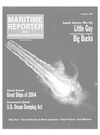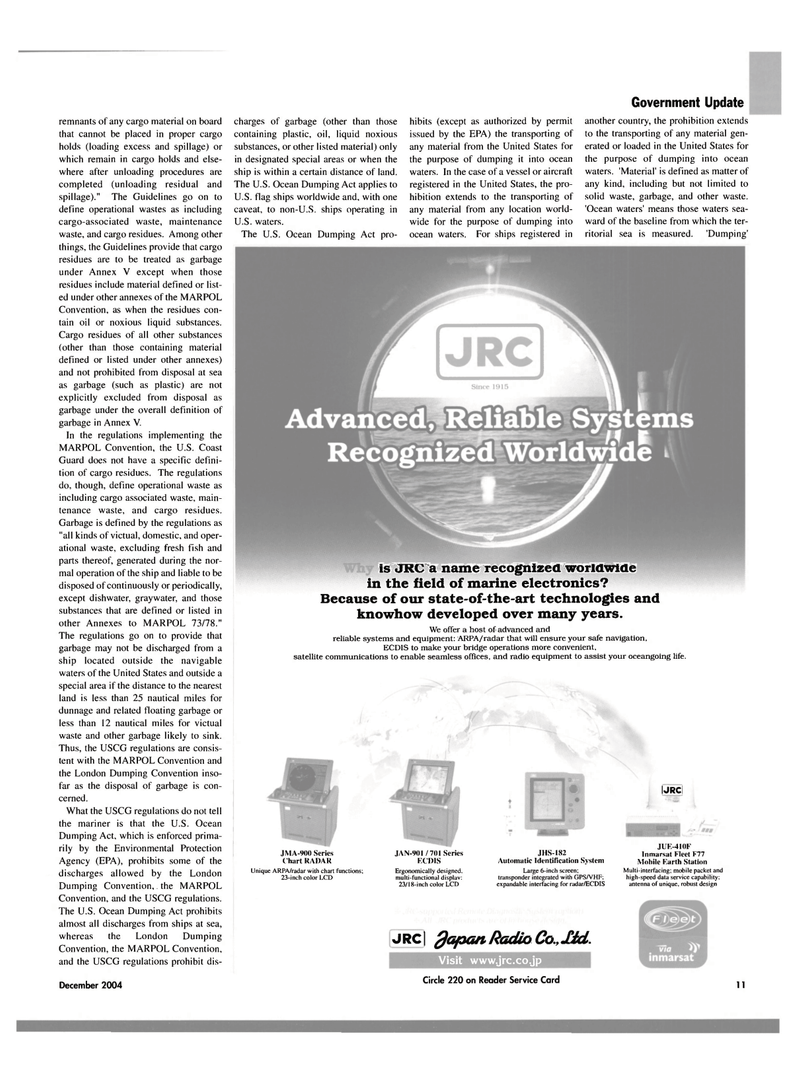
Page 11: of Maritime Reporter Magazine (December 2004)
Great Ships of 2004
Read this page in Pdf, Flash or Html5 edition of December 2004 Maritime Reporter Magazine
remnants of any cargo material on board that cannot be placed in proper cargo holds (loading excess and spillage) or which remain in cargo holds and else- where after unloading procedures are completed (unloading residual and spillage)." The Guidelines go on to define operational wastes as including cargo-associated waste, maintenance waste, and cargo residues. Among other things, the Guidelines provide that cargo residues are to be treated as garbage under Annex V except when those residues include material defined or list- ed under other annexes of the MARPOL
Convention, as when the residues con- tain oil or noxious liquid substances.
Cargo residues of all other substances (other than those containing material defined or listed under other annexes) and not prohibited from disposal at sea as garbage (such as plastic) are not explicitly excluded from disposal as garbage under the overall definition of garbage in Annex V.
In the regulations implementing the
MARPOL Convention, the U.S. Coast
Guard does not have a specific defini- tion of cargo residues. The regulations do, though, define operational waste as including cargo associated waste, main- tenance waste, and cargo residues.
Garbage is defined by the regulations as "all kinds of victual, domestic, and oper- ational waste, excluding fresh fish and parts thereof, generated during the nor- mal operation of the ship and liable to be disposed of continuously or periodically, except dishwater, graywater, and those substances that are defined or listed in other Annexes to MARPOL 73/78."
The regulations go on to provide that garbage may not be discharged from a ship located outside the navigable waters of the United States and outside a special area if the distance to the nearest land is less than 25 nautical miles for dunnage and related floating garbage or less than 12 nautical miles for victual waste and other garbage likely to sink.
Thus, the USCG regulations are consis- tent with the MARPOL Convention and the London Dumping Convention inso- far as the disposal of garbage is con- cerned.
What the USCG regulations do not tell the mariner is that the U.S. Ocean
Dumping Act, which is enforced prima- rily by the Environmental Protection
Agency (EPA), prohibits some of the discharges allowed by the London
Dumping Convention, the MARPOL
Convention, and the USCG regulations.
The U.S. Ocean Dumping Act prohibits almost all discharges from ships at sea, whereas the London Dumping
Convention, the MARPOL Convention, and the USCG regulations prohibit dis- charges of garbage (other than those containing plastic, oil, liquid noxious substances, or other listed material) only in designated special areas or when the ship is within a certain distance of land.
The U.S. Ocean Dumping Act applies to
U.S. flag ships worldwide and, with one caveat, to non-U.S. ships operating in
U.S. waters.
The U.S. Ocean Dumping Act pro- hibits (except as authorized by permit issued by the EPA) the transporting of any material from the United States for the purpose of dumping it into ocean waters. In the case of a vessel or aircraft registered in the United States, the pro- hibition extends to the transporting of any material from any location world- wide for the purpose of dumping into ocean waters. For ships registered in
Government Update another country, the prohibition extends to the transporting of any material gen- erated or loaded in the United States for the purpose of dumping into ocean waters. 'Material' is defined as matter of any kind, including but not limited to solid waste, garbage, and other waste. 'Ocean waters' means those waters sea- ward of the baseline from which the ter- ritorial sea is measured. 'Dumping' |JRC|
JUE-410F
Inmarsat Fleet F77
Mobile Earth Station
Multi-interfacing; mobile packet and high-speed data service capability; antenna of unique, robust design is JRC a name recognized worldwide in the field of marine electronics?
Because of our state-of-the-art technologies and knowhow developed over many years.
We offer a host of advanced and reliable systems and equipment: ARPA/radar that will ensure your safe navigation.
ECDIS to make your bridge operations more convenient, satellite communications to enable seamless offices, and radio equipment to assist your oceangoing life.
JMA-900 Series
Chart RADAR
Unique ARPA/radar with chart functions; 23-inch color LCD
JAN-901 / 701 Series
ECDIS
Economically designed, multi-functional display; 23/18-inch color LCD
JHS-182
Automatic Identification System
Large 6-inch screen; transponder integrated with GPS/VHF; expandable interfacing for radar/ECDIS
JRCj flapan Radio Co., ltd.
Visit www.jrc.co.jp
December 2004 Circle 220 on Reader Service Card 11

 10
10

 12
12
